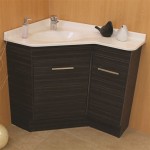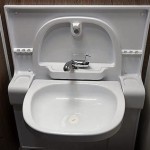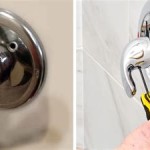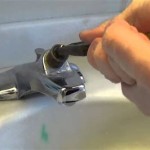Fixing a Leak Under the Bathroom Sink: A Step-by-Step Guide
A leak under the bathroom sink is a common plumbing problem that can quickly escalate into a major issue if left unaddressed. Not only can it damage your cabinets and flooring, but it can also lead to mold growth and water damage. Fortunately, most bathroom sink leaks are relatively easy to fix with the right tools and knowledge. This guide provides a comprehensive walkthrough of the common causes of bathroom sink leaks and offers solutions for each, empowering you to tackle the problem effectively.
1. Identifying the Source of the Leak
The first step in fixing a leak under the bathroom sink is to determine its source. This may seem obvious, but pinpointing the precise location of the leak is crucial for choosing the right repair method. Here are some common culprits to watch out for:
- Loose or Worn-Out Supply Lines: The metal or flexible hoses that connect the sink to the water supply lines can become loose, corroded, or develop pinholes over time.
- Loose or Damaged Faucet Connections: The connections between the faucet and the supply lines can loosen or become damaged, resulting in leaks.
- Worn-Out Faucet Cartridge or O-Rings: The internal components of the faucet, such as the cartridge or o-rings, can wear out and cause leaks.
- Cracked or Leaky Drain Pipes: The drain pipe under the sink can crack or develop leaks, particularly at the connection points.
- Clogged Drain: A clogged drain can cause water to back up and leak from the overflow drain or the sink itself.
To identify the source, carefully inspect the area under the sink, paying attention to the following:
- Water dripping or running from the supply lines: This indicates a problem with the supply lines themselves.
- Water leaking from the faucet base or around the handles: This usually points to a loose or damaged faucet connection or a worn-out cartridge.
- Water pooling under the sink: This could be a sign of a leak in the drain pipe or a clogged drain.
2. Repairing Supply Line Leaks
Leaking supply lines are a common source of bathroom sink leaks. If you notice water dripping from the supply lines, you can often fix the problem yourself.
Materials Needed:
- Adjustable wrench
- Pipe wrench
- New supply lines (if necessary)
- Teflon tape
- Bucket or towel to catch water
- Safety glasses
Steps:
- Turn off the water supply to the sink. Locate the shut-off valves for the hot and cold water lines, usually found under the sink or on the wall behind it.
- Turn on the faucet briefly to drain any remaining water in the lines.
- Carefully inspect the supply lines for signs of damage, leaks, or loose connections.
- If the supply lines are damaged or worn out, you'll need to replace them. To do this, use the pipe wrench to loosen the connections at the shut-off valves and at the faucet.
- If the supply lines are just loose, tighten them using the adjustable wrench. Be careful not to overtighten, as this could damage the connections.
- If you're replacing the supply lines, wrap Teflon tape around the male threads of the new supply lines. This helps to prevent leaks.
- Connect the new supply lines to the shut-off valves and the faucet, making sure they are securely tightened.
- Turn the water supply back on. Test the faucet to ensure it is working properly and there are no leaks.
3. Fixing Faucet Leaks
If the leak is coming from the faucet itself, the problem may lie with the cartridge, O-rings, or loose connections. Here's how you can troubleshoot and fix these issues:
Materials Needed:
- Screwdriver
- Faucet wrench or adjustable wrench
- New faucet cartridge (if necessary)
- New O-rings (if necessary)
- Teflon tape
- Bucket or towel to catch water
- Safety glasses
Steps:
- Turn off the water supply to the sink.
- Remove the faucet handles. Most faucet handles are held in place by screws that can be easily removed with a screwdriver.
- Inspect the connections between the faucet and the supply lines for looseness or damage. Tighten any loose connections using a wrench.
- If the leak is coming from the faucet cartridge, remove it by unscrewing it from the faucet body. Replace the cartridge with a new one, ensuring you have the correct replacement cartridge for your faucet model.
- If the leak is coming from the O-rings, replace them with new ones. O-rings are small, rubber rings that seal the connections between the faucet components.
- Reassemble the faucet, making sure all the connections are tight.
- Turn the water supply back on and test the faucet for leaks.
It is important to note that some faucet leaks may require more advanced repairs, such as replacing the entire faucet or fixing a crack in the faucet body. If you are unsure about repairing a faucet leak yourself, it's best to consult a professional plumber.

How To Fix A Leaking Bathroom Sink Paschal Air Plumbing Electric

Bathroom Sink Drain Leaking Around Threads Premier Plumbing Inc

Common Sink Leaks You Could Probably Fix Yourself

How To Fix Pipework A Tap Faucet Leaking Under The Sink

Bathroom Sink Drain Leaking Around Threads Premier Plumbing Inc

How To Fix Constant Leak Under Bathroom Bunnings Work Community

How To Fix Constant Leak Under Bathroom Bunnings Work Community

How To Fix A Leak Under Your Sink

Hose Under Your Sink Is Leaking Here S What You Have To Do

Bathroom Sink Drain Leak Not Sure How To Fix Doityourself Com Community Forums
Related Posts







